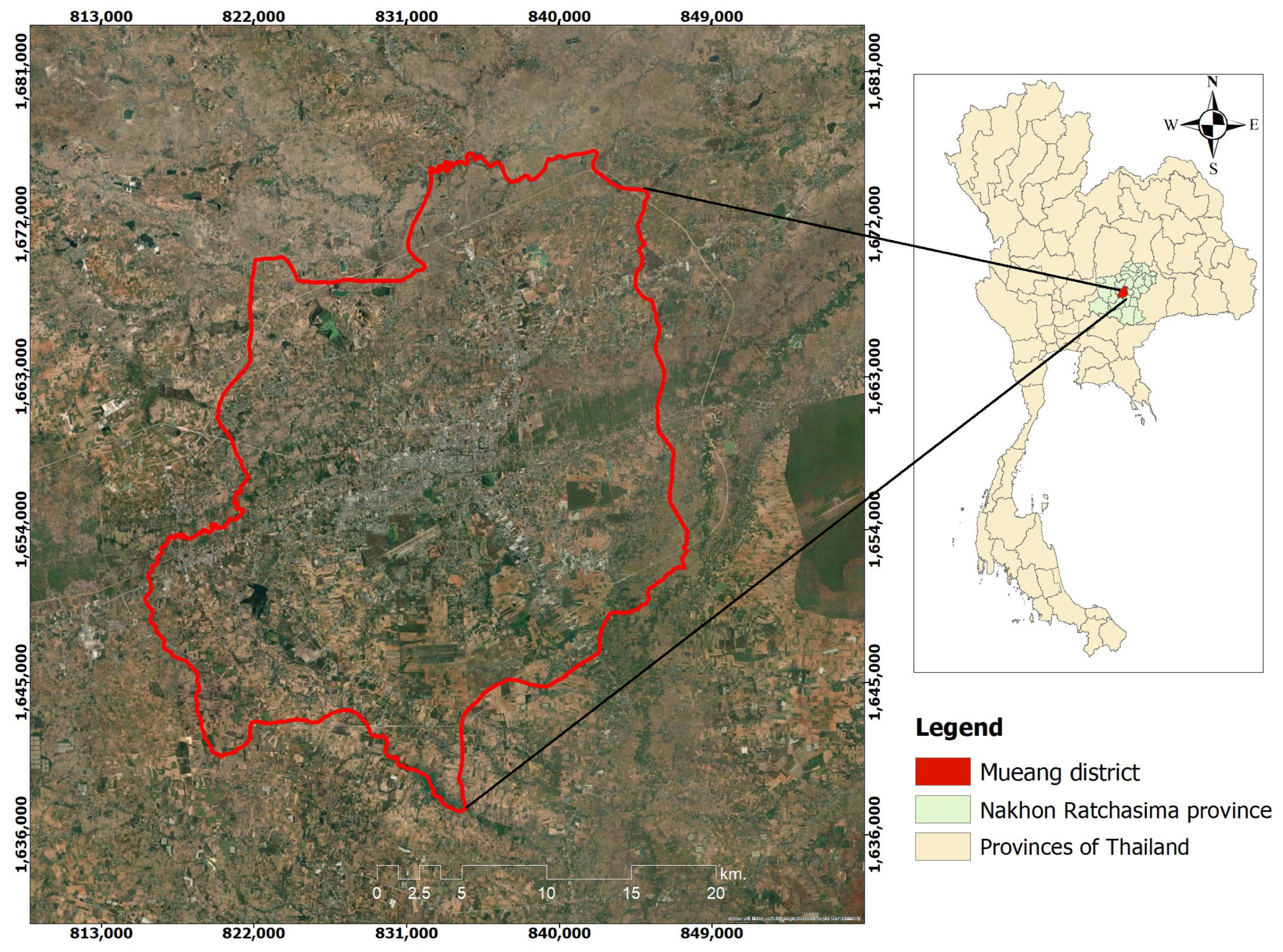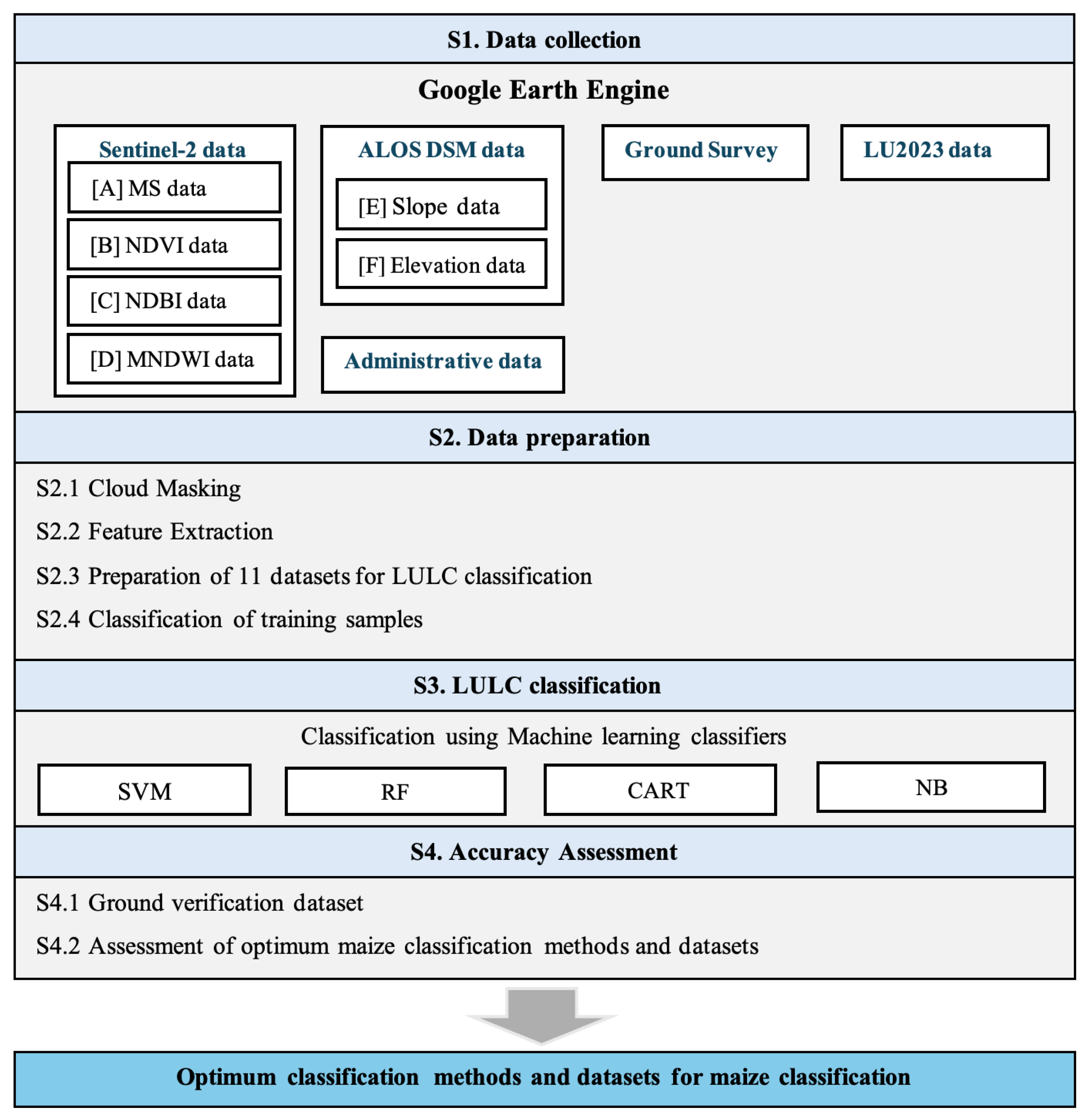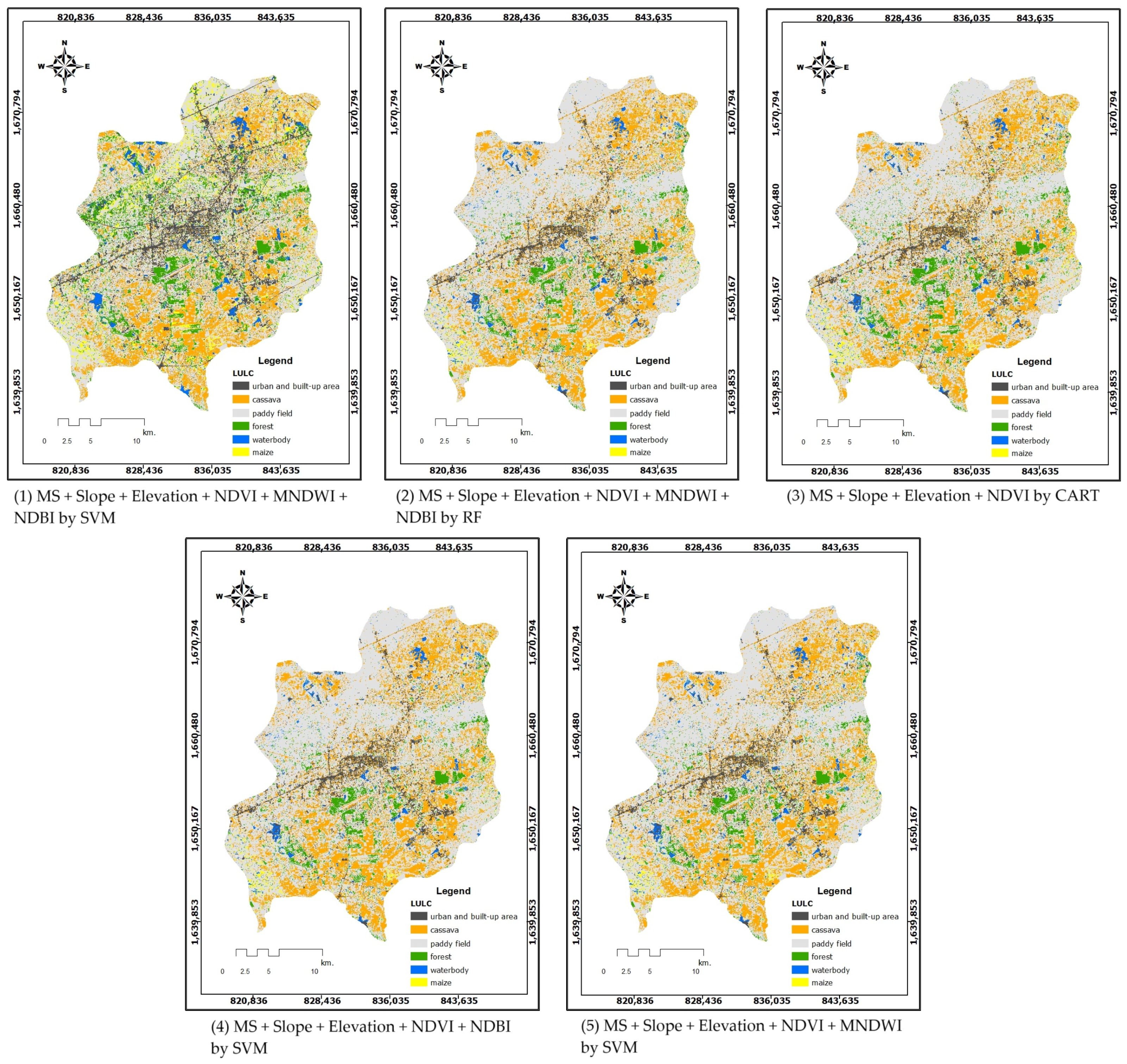Precision Mapping of Fodder Maize Cultivation in Peri-Urban Areas Using Machine Learning and Google Earth Engine
Abstract
1. Introduction
- To accurately classify fodder maize cultivation areas by integrating Google Earth Engine with machine learning techniques.
- To evaluate and compare the classification accuracy of different machine learning algorithms and datasets to identify the most suitable approach for mapping fodder maize fields.
2. Materials and Methods
2.1. Study Area
2.2. Data and Equipment
- Multispectral satellite imagery was acquired from the Sentinel-2A and Sentinel-2B platforms under the Copernicus Sentinel-2 Surface Reflectance (S2_SR) product, provided by the European Space Agency (ESA). Nineteen cloud-free images were selected across tile IDs T47PRS and T48PTB, covering the study area in Mueang District, Nakhon Ratchasima, Thailand. These images were acquired during the dry season, between 11 January and 30 April 2024, to minimize atmospheric interference and improve spectral separability.
- Band 3 (Green: 560 nm);
- Band 4 (Red: 665 nm);
- Band 8 (Near-Infrared: 842 nm);
- Band 11 (Shortwave Infrared: 1610 nm).
- 2.
- Biophysical variables, including elevation and slope, derived from the ALOS World 3D–30 m Digital Elevation Model (DEM), provided by the Japan Aerospace Exploration Agency (JAXA).
- 3.
- Land use data obtained from the Land Development Department of Thailand (2021), which were used as ancillary data for understanding general land use trends and supporting reference-based interpretation.
- 4.
- Global Positioning System (GPS) devices (Garmin eTrex 10), used for field data collection and location validation.
- 5.
- Personal computers, employed for data processing, analysis, and algorithm implementation.
- 6.
- Digital cameras (iPhone series), used for capturing ground reference photos during field surveys to support the interpretation of LULC types.
- 7.
- Administrative boundary maps sourced from the Department of Provincial Administration, Ministry of Interior, Thailand, used for delineating the study area and generating mapping outputs aligned with official territorial extents.
- 8.
- Google Earth Engine (GEE), an open-source, cloud-based geospatial analysis platform used for data processing, classification, and visualization.
2.3. Research Methodology
- −
- A single cloud-free image obtained during the dry season was selected due to its minimal cloud cover and high spectral clarity. Although median composite images from multiple dates may reduce temporal anomalies, such composites in the rainy season are often affected by persistent cloud cover and haze in this region. Therefore, a single high-quality dry season image was preferred.
- −
- Digital elevation and slope data extracted from the ALOS DSM (Digital Surface Model).
- −
- Additional relevant data, including administrative boundary data from FAO, and 2023 land use and land cover data for Nakhon Ratchasima Province, obtained from the Land Use Policy and Planning Division, Department of Land Development, Ministry of Agriculture and Cooperatives, along with ground truth survey data.
3. Results
3.1. Accurate Classification of Maize Cultivation Using Google Earth Engine and Machine Learning
3.2. Accuracy Assessment of Land Use and Land Cover Classification
4. Discussion
5. Conclusions
6. Recommendations
- −
- To enhance the model’s generalizability and applicability, future research should extend the study to other geographic contexts with varied environmental conditions, such as mountainous areas, coastal zones, or irrigated farming regions. This will help assess the robustness and adaptability of the classification framework across diverse landscapes.
- −
- The incorporation of time-series analysis is recommended to capture seasonal variations in cropping patterns and monitor dynamic agricultural processes, particularly during periods of climatic stress such as droughts or excessive rainfall.
- −
- To further refine classification accuracy and spatial resolution, comparative studies utilizing alternative satellite imagery sources—such as Landsat-8, PlanetScope, or unmanned aerial vehicles (UAVs)—should be conducted. These comparisons will provide insights into the trade-offs between data availability, spatial resolution, and processing complexity.
Author Contributions
Funding
Data Availability Statement
Acknowledgments
Conflicts of Interest
References
- Shiferaw, B.; Prasanna, B.M.; Hellin, J.; Bänziger, M. Crops that Feed the World 6: Past Successes and Future Challenges to the Role Played by Maize in Global Food Security. Food Secur. 2011, 3, 307–327. [Google Scholar] [CrossRef]
- Godfray, H.C.J.; Beddington, J.R.; Crute, I.R.; Haddad, L.; Lawrence, D.; Muir, J.F.; Pretty, J.; Robinson, S.; Thomas, S.M.; Toulmin, C. Food Security: The Challenge of Feeding 9 Billion People. Science 2010, 327, 812–818. [Google Scholar] [CrossRef] [PubMed]
- Ray, D.K.; Mueller, N.D.; West, P.C.; Foley, J.A. Yield Trends Are Insufficient to Double Global Crop Production by 2050. PLoS ONE 2013, 8, e66428. [Google Scholar] [CrossRef] [PubMed]
- Agronomy Research Institute and Renewable Energy Plants, Department of Agriculture. 2024. Available online: https://www.doa.go.th/fcri/wp-content/uploads/2024/12/%E0%B8%AA%E0%B8%96%E0%B8%B2%E0%B8%99%E0%B8%81%E0%B8%B2%E0%B8%A3%E0%B8%93%E0%B9%8C%E0%B8%9E%E0%B8%B7%E0%B8%8A-101067.pdf (accessed on 1 July 2025).
- Poramacom, N. Maize Production, Prices and Related Policy in Thailand. Br. J. Arts. Soc. Sci. 2013, 11, 174–185. [Google Scholar]
- Ekasingh, B.; Sungkapitux, C.; Kitchaicharoen, J.; Suebpongsang, P. Maize in Thailand: Production Systems, Constraints, and Research Priorities; CIMMYT: Texcoco, Mexico, 2004. Available online: https://ageconsearch.umn.edu/record/7649/files/mp04ek01.pdf (accessed on 25 April 2025).
- Office of the Permanent Secretary for Ministry of Agriculture and Cooperatives. Nakhon Ratchasima Province. 2019. Available online: https://www.opsmoac.go.th/nakhonratchasima-dwl-files-421091791863 (accessed on 1 July 2025).
- Tharanukul, P.; Surat, S.; Khaephimai, C.; Khongrit, N.; Mungjomklang, S.; Israngkul Na Ayudhya, P. Testing Technologies to Cost Reduction Maize Production by Biofertilizer (PGPR-1) of Nakhon Ratchasima Province. 2021. Available online: https://www.doa.go.th/plan/wp-content/uploads/2023/07/331.3.pdf (accessed on 1 July 2025).
- Aryaguna, P.A.; Danoedoro, P. Comparison Effectiveness of Pixel-Based Classification and Object-Based Classification Using High Resolution Image in Floristic Composition Mapping (Study Case: Gunung Tidar, Magelang City). In Proceedings of the IOP Conference Series: Earth and Environmental Science, Bristol, UK, 17–19 November 2016; IOP Publishing: Bristol, UK, 2016; Volume 47, p. 012042. [Google Scholar]
- Song, K.; Bian, Y.; Wang, D.; Li, R.; Wu, K.; Liu, H.; Qin, C.; Hu, J.; Xiao, L. Advances and challenges of single-pixel imaging based on deep learning. Laser Photonics Rev. 2024, 19, 2401397. [Google Scholar] [CrossRef]
- Singh, M.; Tyagi, K.D. Pixel-Based Classification for Landsat 8 OLI Multispectral Satellite Images Using Deep Learning Neural Network. Remote Sens. Appl. Soc. Environ. 2021, 24, 100645. [Google Scholar] [CrossRef]
- Goel, E.; Abhilasha, E. Random Forest: A Review. Int. J. Adv. Res. Comput. Sci. Softw. Eng. 2017, 7, 251–257. [Google Scholar] [CrossRef]
- Maxwell, A.E.; Warner, T.A.; Fang, F. Implementation of machine-learning classification in remote sensing: An applied review. Int. J. Remote Sens. 2018, 39, 2784–2817. [Google Scholar] [CrossRef]
- Khan, S.; Bhardwaj, A.; Sakthivel, M. Accuracy Assessment of Land Use Land Cover Classification Using Machine Learning Classifiers in Google Earth Engine: A Case Study of Jammu District. In Proceedings of the ISPRS TC IV Mid-Term Symposium “Spatial Information to Empower the Metaverse”, Fremantle, Australia, 22–25 October 2024; Volume 48, pp. 1682–1750. [Google Scholar]
- Neetu; Ray, S.S. Exploring Machine Learning Classification Algorithms for Crop Classification Using Sentinel-2 Data. Int. Arch. Photogramm. Remote Sens. Spat. Inf. Sci. 2019, 42, 573–578. [Google Scholar] [CrossRef]
- Blind, K.; Böhm, M.; Grzegorzewska, P.; Katz, A.; Muto, S.; Pätsch, S.; Schubert, T. The Impact of Open Source Software and Hardware on Technological Independence, Competitiveness and Innovation in the EU Economy; Final Study Report; European Commission: Brussels, Belgium, 2021. [Google Scholar] [CrossRef]
- Phongphan, J.; Jiraphat, B.; Propran, B.; Yaowaret, J.; Piyachai, C. Guidelines for the Application of Google Earth Engine for Monitoring and Evaluating Natural Disaster Damage. In Proceedings of the 26th National Civil Engineering Conference, Online Conference, 23–25 June 2021. [Google Scholar]
- Shelestov, A.; Lavreniuk, M.; Kussul, N.; Novikov, A.; Skakun, S. Exploring Google Earth Engine Platform for Big Data Processing: Classification of Multi-Temporal Satellite Imagery for Crop Mapping. Front. Earth Sci. 2017, 5, 232994. [Google Scholar] [CrossRef]
- Xie, S.; Liu, L.; Zhang, X.; Yang, J.; Chen, X.; Gao, Y. Automatic Land-Cover Mapping Using Landsat Time-Series Data Based on Google Earth Engine. Remote Sens. 2019, 11, 3023. [Google Scholar] [CrossRef]
- Intarat, K. Land Use Classification in Nakhon Nayok Province Using Machine Learning Algorithms and Sentinel-2 Image. Burapha Sci. J. 2022, 27, 1153–1171. [Google Scholar]
- Rouse, J.W.; Haas, R.H.; Schell, J.A.; Deering, D.W. Monitoring vegetation systems in the Great Plains with ERTS. Third NASA Earth Resour. Technol. Satell. Symp. 1974, 1, 309–317. [Google Scholar]
- Gao, B.-C. NDWI—A normalized difference water index for remote sensing of vegetation liquid water from space. Remote Sens. Environ. 1996, 58, 257–266. [Google Scholar] [CrossRef]
- Zha, Y.; Gao, J.; Ni, S. Use of normalized difference built-up index in automatically mapping urban areas from TM imagery. Int. J. Remote Sens. 2003, 24, 583–594. [Google Scholar] [CrossRef]




| Dataset | Bands (B3, B4, B8) | Slope | Elevation | NDVI | MNDWI | NDBI | SVM | RF | CART | NB | ||||
|---|---|---|---|---|---|---|---|---|---|---|---|---|---|---|
| OA | OA | OA | OA | |||||||||||
| 1 | ✓ | 87.56 | 85.27 | 86.53 | 84.18 | 89.64 | 87.81 | 78.24 | 74.30 | |||||
| 2 | ✓ | ✓ | 89.12 | 87.21 | 92.23 | 90.84 | 91.19 | 89.64 | 78.24 | 74.10 | ||||
| 3 | ✓ | ✓ | 91.71 | 90.23 | 91.19 | 89.71 | 91.19 | 89.65 | 77.20 | 73.05 | ||||
| 4 | ✓ | ✓ | ✓ | 92.23 | 90.86 | 94.82 | 93.94 | 95.85 | 95.12 | 77.20 | 73.13 | |||
| 5 | ✓ | ✓ | ✓ | ✓ | 93.26 | 92.09 | 95.85 | 95.10 | 93.26 | 92.03 | 80.83 | 77.33 | ||
| 6 | ✓ | ✓ | ✓ | ✓ | 91.19 | 89.55 | 94.30 | 93.27 | 92.23 | 90.76 | 83.42 | 80.25 | ||
| 7 | ✓ | ✓ | ✓ | ✓ | 94.30 | 93.32 | 95.34 | 94.54 | 96.37 | 95.75 | 76.68 | 72.62 | ||
| 8 | ✓ | ✓ | ✓ | ✓ | ✓ | 95.85 | 95.14 | 94.30 | 93.35 | 92.23 | 90.91 | 76.68 | 72.51 | |
| 9 | ✓ | ✓ | ✓ | ✓ | ✓ | 95.85 | 94.94 | 96.37 | 95.73 | 92.23 | 90.60 | 88.08 | 85.43 | |
| 10 | ✓ | ✓ | ✓ | ✓ | ✓ | 95.85 | 95.15 | 94.30 | 93.31 | 95.85 | 95.14 | 80.31 | 76.86 | |
| 11 | ✓ | ✓ | ✓ | ✓ | ✓ | ✓ | 97.41 | 96.97 | 96.89 | 96.35 | 95.34 | 94.51 | 79.79 | 76.19 |
| Class | Land Use and Land Cover Types | Area (sq.km.) | Area (rai) | Area (Hectares) |
|---|---|---|---|---|
| 1 | Urban and built-up area (UR) | 76.86 | 48,037.50 | 7686.00 |
| 2 | Cassava (CA) | 141.05 | 88,156.25 | 14,105.00 |
| 3 | Paddy field (PF) | 422.20 | 263,875.00 | 42,220.00 |
| 4 | Forest (FO) | 57.82 | 36,137.50 | 5782.00 |
| 5 | Waterbody (WA) | 17.85 | 11,156.25 | 1785.00 |
| 6 | Maize (MA) | 39.78 | 24,862.50 | 3978.00 |
| Total | 755.56 | 472,225.00 | 75,556.00 | |
| Classified Data | Reference Data | Total | OA | ||||||||
|---|---|---|---|---|---|---|---|---|---|---|---|
| UR | CA | PF1 | PF2 | PF3 | FO | WA1 | WA2 | MA | |||
| UR | 15 | 0 | 0 | 0 | 0 | 0 | 0 | 0 | 0 | 15 | 100.00 |
| CA | 0 | 42 | 1 | 0 | 0 | 0 | 0 | 0 | 0 | 43 | 97.67 |
| PF1 | 0 | 0 | 13 | 0 | 0 | 0 | 0 | 0 | 0 | 13 | 100.00 |
| PF2 | 0 | 0 | 0 | 39 | 0 | 0 | 0 | 0 | 0 | 39 | 100.00 |
| PF3 | 0 | 0 | 0 | 1 | 23 | 0 | 0 | 0 | 0 | 24 | 95.83 |
| FO | 0 | 0 | 2 | 0 | 0 | 17 | 0 | 0 | 0 | 19 | 89.47 |
| WA1 | 0 | 0 | 0 | 0 | 0 | 0 | 7 | 0 | 0 | 7 | 100.00 |
| WA2 | 0 | 0 | 0 | 1 | 0 | 0 | 0 | 7 | 0 | 8 | 87.50 |
| MA | 0 | 0 | 0 | 0 | 0 | 0 | 0 | 0 | 25 | 25 | 100.00 |
| Total | 15 | 42 | 16 | 41 | 23 | 17 | 7 | 7 | 25 | 193 | |
| PA | 100.00 | 100.00 | 81.25 | 95.12 | 100.00 | 100.00 | 100.00 | 100.00 | 100.00 | ||
| Overall accuracy = 97.41% | |||||||||||
| Kappa coefficient = 96.97% | |||||||||||
| Dataset | SVM | RF | CART | NB | ||||
|---|---|---|---|---|---|---|---|---|
| 1 | 82.98 | 73.59 | 59.90 | 78.19 | 87.08 | 87.08 | 69.49 | 55.40 |
| 2 | 79.24 | 82.67 | 87.47 | 87.47 | 94.78 | 81.94 | 78.34 | 52.67 |
| 3 | 86.30 | 90.43 | 86.21 | 86.21 | 95.32 | 83.59 | 82.66 | 61.38 |
| 4 | 94.59 | 85.36 | 86.21 | 86.21 | 95.32 | 83.59 | 85.70 | 66.65 |
| 5 | 95.06 | 95.06 | 90.19 | 94.84 | 90.13 | 90.13 | 94.82 | 67.04 |
| 6 | 82.98 | 90.70 | 83.08 | 95.16 | 87.16 | 91.06 | 78.21 | 71.94 |
| 7 | 91.11 | 91.11 | 91.16 | 95.38 | 95.58 | 100.00 | 84.24 | 69.61 |
| 8 | 95.03 | 90.54 | 95.03 | 90.54 | 95.03 | 90.54 | 100.00 | 60.17 |
| 9 | 100.00 | 91.22 | 100.00 | 91.49 | 100.00 | 91.22 | 90.81 | 90.81 |
| 10 | 94.90 | 100.00 | 95.40 | 95.40 | 100.00 | 95.58 | 90.35 | 65.19 |
| 11 | 100.00 | 100.00 | 100.00 | 91.49 | 100.00 | 91.49 | 90.35 | 65.19 |
Disclaimer/Publisher’s Note: The statements, opinions and data contained in all publications are solely those of the individual author(s) and contributor(s) and not of MDPI and/or the editor(s). MDPI and/or the editor(s) disclaim responsibility for any injury to people or property resulting from any ideas, methods, instructions or products referred to in the content. |
© 2025 by the authors. Licensee MDPI, Basel, Switzerland. This article is an open access article distributed under the terms and conditions of the Creative Commons Attribution (CC BY) license (https://creativecommons.org/licenses/by/4.0/).
Share and Cite
Plaiklang, S.; Meengoen, P.; Montre, W.; Puttinaovarat, S. Precision Mapping of Fodder Maize Cultivation in Peri-Urban Areas Using Machine Learning and Google Earth Engine. AgriEngineering 2025, 7, 302. https://doi.org/10.3390/agriengineering7090302
Plaiklang S, Meengoen P, Montre W, Puttinaovarat S. Precision Mapping of Fodder Maize Cultivation in Peri-Urban Areas Using Machine Learning and Google Earth Engine. AgriEngineering. 2025; 7(9):302. https://doi.org/10.3390/agriengineering7090302
Chicago/Turabian StylePlaiklang, Sasikarn, Pharkpoom Meengoen, Wittaya Montre, and Supattra Puttinaovarat. 2025. "Precision Mapping of Fodder Maize Cultivation in Peri-Urban Areas Using Machine Learning and Google Earth Engine" AgriEngineering 7, no. 9: 302. https://doi.org/10.3390/agriengineering7090302
APA StylePlaiklang, S., Meengoen, P., Montre, W., & Puttinaovarat, S. (2025). Precision Mapping of Fodder Maize Cultivation in Peri-Urban Areas Using Machine Learning and Google Earth Engine. AgriEngineering, 7(9), 302. https://doi.org/10.3390/agriengineering7090302








